Thermodynamic and Economic Simulation of an Organic Rankine Cycle for the Utilization of Combustion Gas Produced in Small Landfills in Antioquia, Colombia
Abstract
:1. Introduction
2. Case Study
3. Materials and Methods
3.1. Thermodynamic Modelling and Simulation
3.2. Environmental Analysis
+ Slopes (15%) + Drainage Density (10%)
3.3. Economic Analysis
4. Results and Discussion
4.1. Thermodynamic Modeling and Simulation
4.2. Environmental Analysis
4.3. Economic Analysis
5. Conclusions
Author Contributions
Funding
Data Availability Statement
Conflicts of Interest
References
- Wilmoth, M.J.; Menozzi, M.C.; Bassarsky, M.L. Why Population Growth Matters for Sustainable Development; United Nations: New York, NY, USA, 2022. [Google Scholar]
- Parvin, F.; Tareq, S.M. Impact of landfill leachate contamination on surface and groundwater of Bangladesh: A systematic review and possible public health risks assessment. Appl. Water Sci. 2021, 11, 100. [Google Scholar] [CrossRef] [PubMed]
- Vaverková, M.D. Landfill Impacts on the Environment—Review. Geosciences 2019, 9, 431. [Google Scholar] [CrossRef]
- Šourková, M.; Adamcová, D.; Zloch, J.; Skutnik, Z.; Vaverková, M.D. Evaluation of the Phytotoxicity of Leachate from a Municipal Solid Waste Landfill: The Case Study of Bukov Landfill. Environments 2020, 7, 111. [Google Scholar] [CrossRef]
- Lee, S. Role of social and solidarity economy in localizing the sustainable development goals. Int. J. Sustain. Dev. World Ecol. 2020, 27, 65–71. [Google Scholar] [CrossRef]
- Colomer Mendoza, F.J.; Gallardo Izquierdo, A.; Campos Rodríguez, R.; Arias Aguilar, D. Aprovechamiento Energético de Residuos Sólidos, 1st ed.; Universidad Jaume I: Castelló, Spain, 2019. [Google Scholar]
- Rodríguez Arenillos, M.G.; Pizzani Corrales, P.G.; De Martino, G.; Ojeda Ojeda, L.E.; Ramírez Portillo, R.A.; de la C Noguera-Machado, N. Efecto de la lisozima sobre la emisión in vitro de CO2 y perdidas energéticas de CH4 en bovinos. Rev. Cienc. Y Tecnol. 2022, 15, 49–55. [Google Scholar] [CrossRef]
- Cerrada Galán, A. Análisis de Ciclos de Rankine Orgánicos. Bachelor’s Thesis, Universidad de Sevilla, Sevilla, Spain, 2020. [Google Scholar]
- Li, L.; Ge, Y.T.; Luo, X.; Tassou, S.A. Experimental investigations into power generation with low grade waste heat and R245fa Organic Rankine Cycles (ORCs). Appl. Therm. Eng. 2017, 115, 815–824. [Google Scholar] [CrossRef]
- Aracil, C.; Haro, P.; Fuentes-Cano, D.; Gómez-Barea, A. Implementation of waste-to-energy options in landfill-dominated countries: Economic evaluation and GHG impact. Waste Manag. 2018, 76, 443–456. [Google Scholar] [CrossRef]
- Anastasovski, A.; Rasković, P.; Guzović, Z. A review of heat integration approaches for organic rankine cycle with waste heat in production processes. Energy Convers. Manag. 2020, 221, 113175. [Google Scholar] [CrossRef]
- Gewald, D.; Siokos, K.; Karellas, S.; Spliethoff, H. Waste heat recovery from a landfill gas-fired power plant. Renew. Sustain. Energy Rev. 2012, 16, 1779–1789. [Google Scholar] [CrossRef]
- Sununta, N.; Sedpho, S.; Gheewala, S.H.; Sampattagul, S. Life cycle greenhouse gas evaluation of organic rankine cycle using refuse-derived fuel from municipal solid waste. J. Renew. Sustain. Energy 2017, 9, 54901. [Google Scholar] [CrossRef]
- Arabkoohsar, A.; Nami, H. Thermodynamic and economic analyses of a hybrid waste-driven CHP–ORC plant with exhaust heat recovery. Energy Convers. Manag. 2019, 187, 512–522. [Google Scholar] [CrossRef]
- Soffiato, M.; Frangopoulos, C.A.; Manente, G.; Rech, S.; Lazzaretto, A. Design optimization of ORC systems for waste heat recovery on board a LNG carrier. Energy Convers. Manag. 2015, 92, 523–534. [Google Scholar] [CrossRef]
- Lin, S.; Zhao, L.; Deng, S.; Ni, J.; Zhang, Y.; Ma, M. Dynamic performance investigation for two types of ORC system driven by waste heat of automotive internal combustion engine. Energy 2019, 169, 958–971. [Google Scholar] [CrossRef]
- Ministerio de Vivienda de Colombia. Disposicion Final. 2020. Available online: https://www.minvivienda.gov.co/sites/default/files/2020-09/disposicion-final.pdf (accessed on 20 July 2023).
- Durán Contreras, M. A Look to the Biogas Generation from Organic Wastes in Colombia. Int. J. Energy Econ. Policy 2020, 10, 248–254. [Google Scholar] [CrossRef]
- Suárez, P.; César, R. Analysis of the Situation of Deforestation and Road Transport Greenhouse Emissions for the Next Decade in Colombia. Master’s Thesis, Lund University, Lund, Sweden, 2019. [Google Scholar]
- Espinal, L.S. Geografia Ecologica del Departamento de Antioquia (Zonas de Vida (Formaciones Vegetales) del Departamento De Antioquia); Universidad Nacional de Colombia: Medellin, Colombia, 1964; Volume 38, No. 1. [Google Scholar]
- Martínez, E.J. Análisis de la Virtualidad en las Ciencias Exactas Para Administración de Empresas: Una Reflexión Tecnopedagógica en la Corporación Universitaria Americana; Corporación Universitaria Americana: Medellin, Colombia, 2018. [Google Scholar]
- Brida, J.G.; Monterubbianesi, P.D.; Zapata Aguirre, S.; Giraldo Velásquez, C.M. Turismo y crecimiento económico: El caso de Antioquia. Tur. Y Desarro. Rev. Investig. En Tur. Y Desarro. Local 2010, 3, 1–15. [Google Scholar]
- García Reinoso, P.L.; Méndez Monroy, J.F.; Zarate Jiménez, M.F. Delimitation of Colombia hydrologic regions. Ing. y Desarro. 2017, 35, 132–151. [Google Scholar] [CrossRef]
- Méndez Galvis, L.M.; Otálvaro, G.V. Estudio de la Biónica Como Metodología Aplicable en Ingeniería de Diseño de Producto y su Formalización a Través de una Propuesta de Investigación del Semillero HECAS-ID de la Universidad Eafit. Bachelor’s Thesis, Universidad EAFIT, Medellin, Colombia, 2006. [Google Scholar]
- Zuleta, I.C. Hidroituango: Un desastre socioambiental con responsabilidad internacional. IdeAs 2021, 17, 1–7. [Google Scholar] [CrossRef]
- Restrepo-Trujillo, J.; Moreno-Chuquen, R.; Jiménez-García, F.; Flores, W.; Chamorro, H. Scenario Analysis of an Electric Power System in Colombia Considering the El Niño Phenomenon and the Inclusion of Renewable Energies. Energies 2022, 15, 6690. [Google Scholar] [CrossRef]
- Abilmagzhanov, A.Z.; Ivanov, N.S.; Kholkin, O.S.; Adelbaev, I.E. Assessment of the Energetical and Biological Characteristics of Municipal Solid Waste from One of the Largest Landfills in Kazakhstan. Recycling 2022, 7, 80. [Google Scholar] [CrossRef]
- Castro Guamán, J.O. Análisis del Estado Actual en el Manejo de Residuos Sólidos en Antioquia. Bachelor’s Thesis, Universidad EAFIT, Medellin, Colombia, 2021. [Google Scholar]
- Gobernacion de Antioquia. Plan de desarrollo Antioquia: Unidos por la vida 2020–2023. Gob Antioq. 2020, 321–570. Available online: https://antioquia.gov.co/prensa/hist%C3%B3rico-de-prensa-2/8816-el-plan-de-desarrollo-unidos-por-la-vida-20202023-un-ejercicio-de-descentralizacion-de-gobierno-para-la-equidad (accessed on 20 July 2023).
- López, Y.; Franco, B. Gestión de residuos sólidos urbanos: Un enfoque en Colombia y el departamento de Antioquia. Cuad. Act. Rev. Científica LA Fac. Ing. 2020, 11, 133–154. [Google Scholar]
- Alcaldia de Angosturas. Proyecto plan de Desarrollo 2020–2023. Angosturas. 2020. Available online: https://www.angostura-antioquia.gov.co/noticias/conozca-el-proyecto-del-plan-de-desarrollo-20202023 (accessed on 20 July 2023).
- Rocha-Meneses, L.; Silva, J.C.; Cota, S.; Kikas, T. Thermodynamic, Environmental and Economic Simulation of an Organic Rankine Cycle (ORC) for Waste Heat Recovery: Terceira Island Case Study. Environ. Clim. Technol. 2019, 23, 347–365. [Google Scholar] [CrossRef]
- Li, J.; Alvi, J.Z.; Pei, G.; Su, Y.; Li, P.; Gao, G.; Ji, J. Modelling of organic Rankine cycle efficiency with respect to the equivalent hot side temperature. Energy 2016, 115, 668–683. [Google Scholar] [CrossRef]
- Liu, S.; Dai, B.; Zhang, W.; Li, X. Experimental Study on R245fa Condensation Heat Transfer Properties in Horizontal Tube. Energy Procedia 2016, 104, 419–424. [Google Scholar] [CrossRef]
- Corantioquia. Elaboracion de los Estudios y Diseños Para el Nuevo Sitio de Deposicion Final de Residuos Solidos en el Municipio de Angosturas. Angosturas. 2009. Available online: https://www.corantioquia.gov.co/ciadoc/RESIDUOS%20SOLIDOS/GA_CN_8240_2008.pdf (accessed on 20 July 2023).
- Poma, P.; Usca, M.; Polanco, M.; Toulkeridis, T.; Mestanza-Ramón, C. Estimation of Biogas Generated in Two Landfills in South-Central Ecuador. Atmosphere 2021, 12, 1365. [Google Scholar] [CrossRef]
- Corantioquia. Aunar Esfuerzos Para Realizar los Estudios Básicos Para la Delimitación de Amenazas Naturales y Zonificación de Áreas con Condición de Amenaza y Riesgo a Partir de Investigación Aplicada en Once Municipios de la Jurisdicción de Corantioquia. Municipio de Angostura 2015. Available online: https://www.corantioquia.gov.co/ciadoc/SUELO/AIRNR_CV_1502_6_2015_DOCTMETODOLOGICO_ANGOSTURA.pdf (accessed on 20 July 2023).
- Bell, I.H.; Wronski, J.; Quoilin, S.; Lemort, V. Pure and pseudo-pure fluid thermophysical property evaluation and the open-source thermophysical property library coolprop. Ind. Eng. Chem. Res. 2014, 53, 2498–2508. [Google Scholar] [CrossRef]
- Villamil Fernández, N. Propuesta Conceptual Matemática Para la Implementación de un Ciclo Rankine de Transformación Energética, a Partir de la Fuente Termal Aguacaliente, Caso de Estudio Finca Santa Rosa. Bachelor’s Thesis, Universidad del Bosque, Pachavita, Boyacá, 2022. [Google Scholar]
- Garc, M.A.; Castillo-su, L.A.; Linares-hern, I. Los rellenos sanitarios como fuente de contaminación del agua subterránea por infiltración de lixiviados: Efectos en la salud y el medio ambiente of leachate: Effects on health and environment. Ideas En Cienc. De La Ing. 2022, 1, 4–15. [Google Scholar]
- Oscar, A.; Sanchez, E. Evaluación del Sistema de Tratamiento de Lixiviado del Botadero en el Cantón Nobol Provincia del Guayas. Facultad de Ciencias Matematicas y Fisicas. Bachelor’s Thesis, Universidad de Guayaquil, Guayaquil, Ecuador, 2022. [Google Scholar]
- Abijith, D.; Saravanan, S.; Singh, L.; Jennifer, J.J.; Saranya, T.; Parthasarathy, K.S.S. GIS-based multi-criteria analysis for identification of potential groundwater recharge zones—A case study from Ponnaniyaru watershed, Tamil Nadu, India. HydroResearch 2020, 3, 1–14. [Google Scholar] [CrossRef]
- Biezma, M.V.; Cristóbal, J.R.S. Investment criteria for the selection of cogeneration plants—A state of the art review. Appl. Therm. Eng. 2006, 26, 583–588. [Google Scholar] [CrossRef]
- Rentizelas, A.; Karellas, S.; Kakaras, E.; Tatsiopoulos, I. Comparative techno-economic analysis of ORC and gasification for bioenergy applications. Energy Convers. Manag. 2009, 50, 674–681. [Google Scholar] [CrossRef]
- Gobierno de Colombia. Tarifas para Servicios de Energía–EPM 2022. Available online: https://www.datos.gov.co/Funci-n-p-blica/Tarifas-para-Servicios-de-Energ-a-EPM/sfcd-b3ey (accessed on 20 July 2023).
- Wu, C. Thermodynamics and Heat Powered Cycles; Nova Science Publisher: New York, NY, USA, 2006. [Google Scholar]
- Vasquez, E.G. Afectaciones Ambientales de los Lixiviados Generados en los Rellenos Sanitarios Sobre el Recurso Agua. Specialization’s Thesis, Universidad Industrial de Santander, Bucaramanga, Colombia, 2018. Available online: http://tangara.uis.edu.co/biblioweb/tesis/2018/173184.pdf (accessed on 17 June 2023).
- Baghanam, A.H.; Nourani, V.; Aslani, H.; Taghipour, H. Spatiotemporal variation of water pollution near landfill site: Application of clustering methods to assess the admissibility of LWPI. J. Hydrol. 2020, 591, 125581. [Google Scholar] [CrossRef]
- Weather Spark. El Clima y el Tiempo Promedio en Todo el año en Angostura 2022. Available online: https://es.weatherspark.com/y/22513/Clima-promedio-en-Angostura-Colombia-durante-todo-el-a%C3%B1o (accessed on 20 July 2023).
- Figueredo, J. Metodología Para Determinar Zonas De Recarga Hídrica En Municipios O Comunidades Con Recursos Financieros Limitados; Universidad Militar Nueva Granada: Bogotá, Colombia, 2019; pp. 1–24. [Google Scholar]
- Francisco Jose, T.G. Implicaciones en la Variación de la Morfología, la Vegetación y la Climatología en la Recarga Potencial de Bloque de Montaña en una Región Semiárida Mediterránea. Bachelor’s Thesis, Centro de Investigación Científica y de Educación Superior de Ensenada, Bajo California, Mexico, 2019. [Google Scholar]
- Manuel García, R. La hidrosfera y el ciclo del agua. La contaminación del agua. Métodos de análisis y depuración y el problema de la escasez de agua. Biol. Y Geol. 2009, 72, 112–116. [Google Scholar]
- Montalvo, J.S.; Quispe, M. Contaminación del Agua Superficial por Lixiviados de un Relleno Sanitario. Repos UCV 2018:358. Bachelor’s Thesis, Universidad Privada del Norte, Trujillo, Perú, 2022. [Google Scholar]
- Ramírez Granados, P.; Astorga Gättgens, A.; Campos Bejarano, L.; Henríquez Henríquez, C.; Ramírez-Granados, P.; Astorga-Gättgens, A.; Campos-Bejarano, L.; Henríquez, C.H. Morfometría de la cuenca alta del río Páez, Costa Rica, y su relación con la infiltración. UNED Res. J. 2020, 12, e3142. [Google Scholar] [CrossRef]
- Londoño, G.A. Geoformas asociadas al batolito antioqueño. Geol. Colomb. Int. J. Geosci. 1998, 23, 133–145. [Google Scholar]
- Servicio Geologico Colombiano. Geoportal 2020. Available online: https://www2.sgc.gov.co/sgc/mapas/paginas/geoportal.aspx (accessed on 20 July 2023).
- Alfaro, I.A.; Chavez, J.A.; Cuestas, I.E.; Mejía, C.J.; Landaverde, M.; Campos, S.; Alfaro, I.A.; Chavez, J.A.; Cuestas, I.E.; Mejía, C.J.; et al. Estudio sobre infiltración y su relación con la geología del Área Metropolitana de San Salvador, El Salvador. Rev. Geológica América Cent. 2020, 63, 40–57. [Google Scholar]
- Yury, Q.S.; German, J.L. Determinación de los Índices de Calidad del Agua (ICA), Índices de Contaminación del Agua (ICOs), Metales Pesados 50 Metros Aguas Arriba (Coordenadas 7°22′53.75′′ N-72°53′54.16′′ O) y 50 Metros Aguas Abajo (Coordenadas 7°22′50.60′′ N-72°53′54.79′′ O) de un Punto de Vertimiento en la Quebrada Angosturas del municipio California (Santander) y su Evaluación de Impacto Ambiental. n.d. Bachelor’s Thesis, Universidad Nacional Abierta y a Distancia, Bucaramanga, Colombia, 2022. [Google Scholar]
- Banco de la Republica (Colombia). Tasas de Interés y Sector Financiero. 2023. Available online: https://www.banrep.gov.co/es/estadisticas/tasas-de-interes-y-sector-financiero (accessed on 20 July 2023).
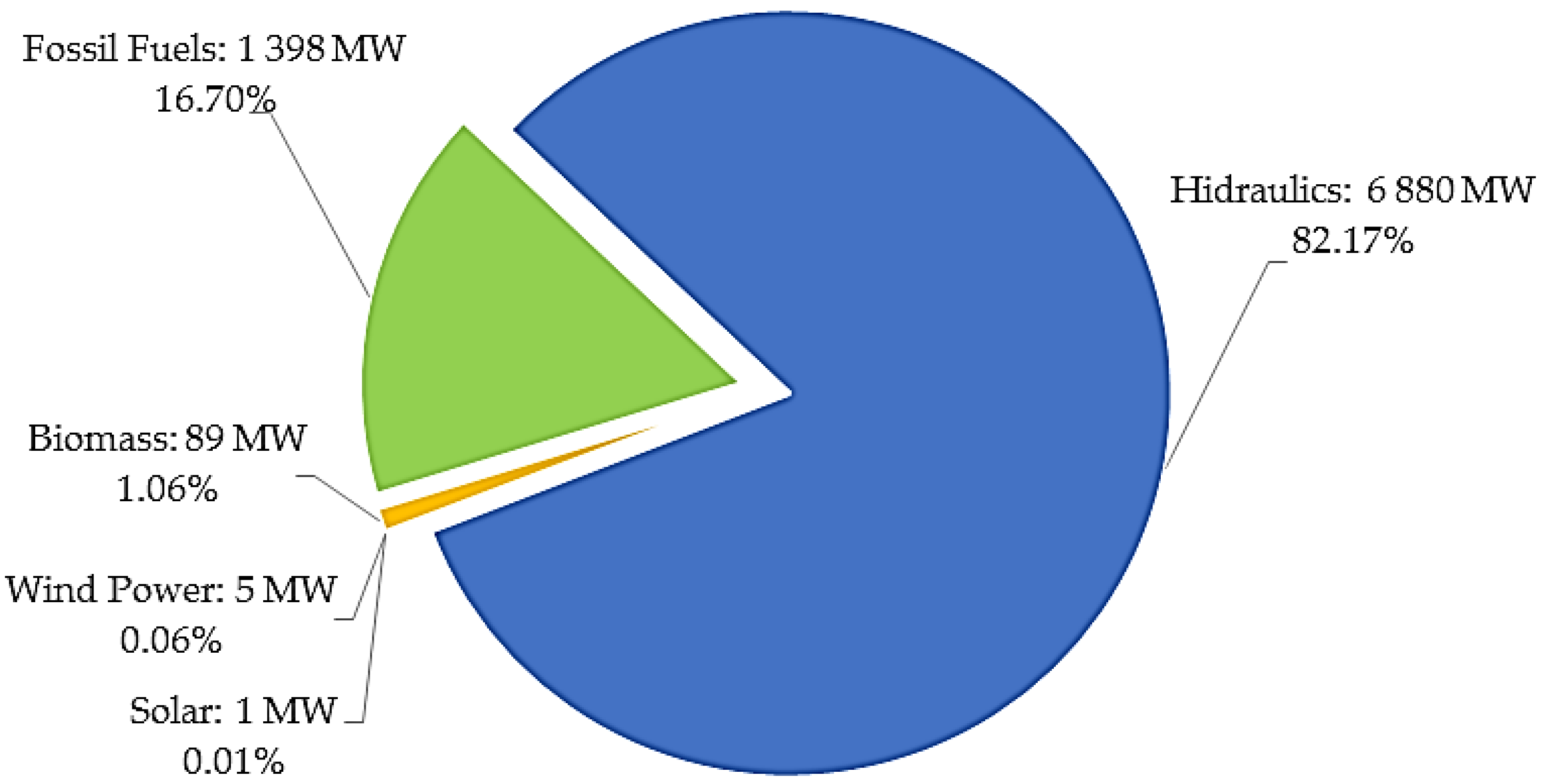


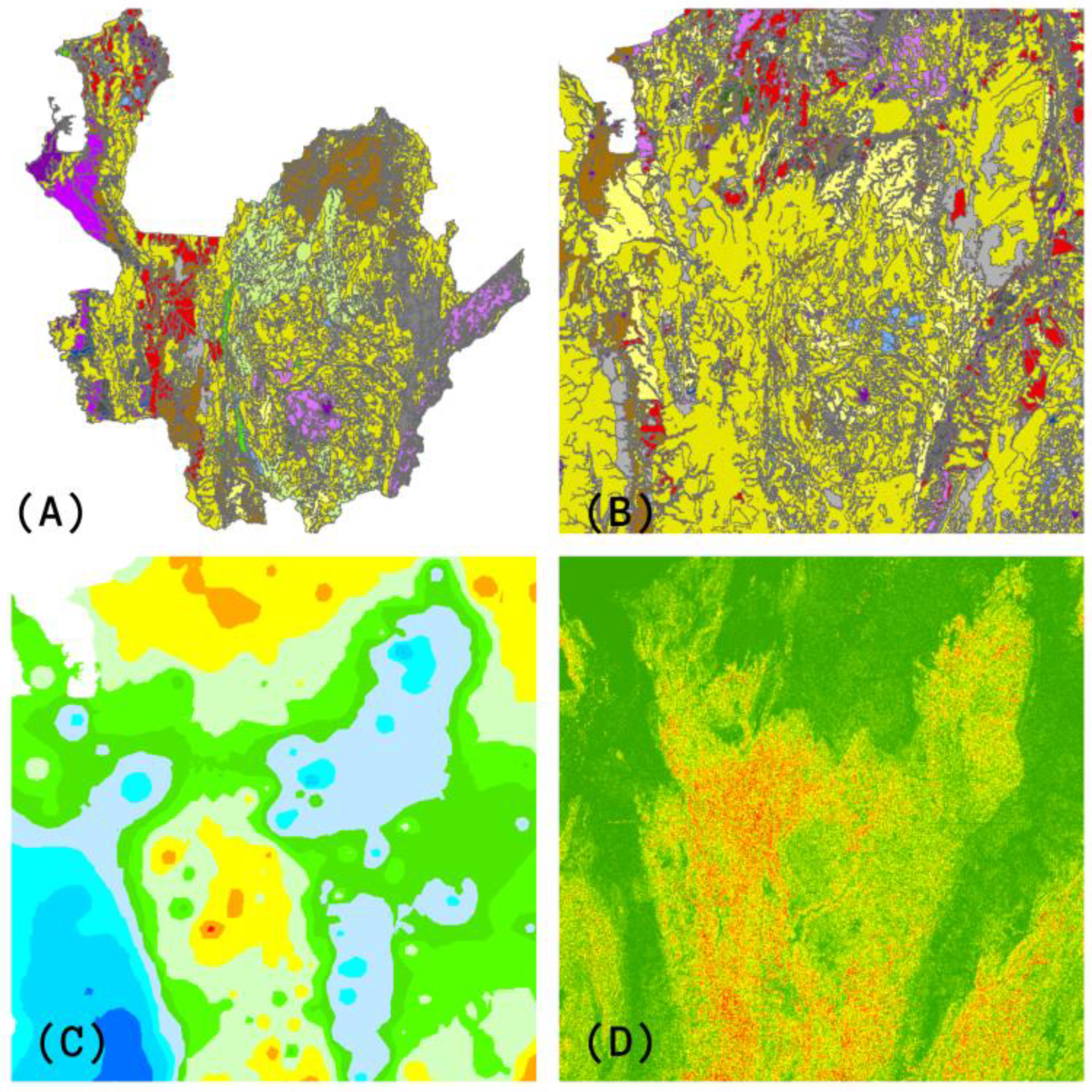
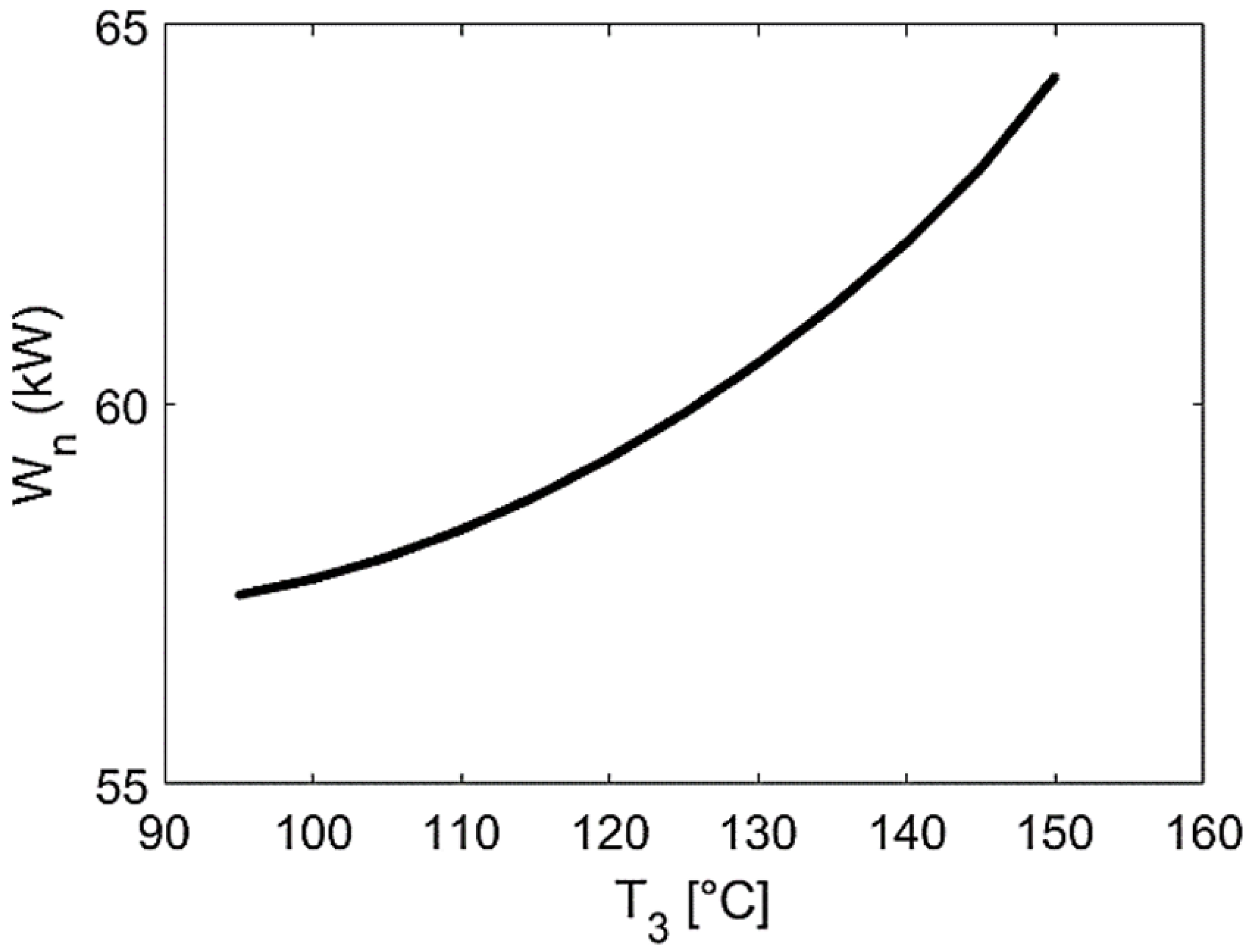
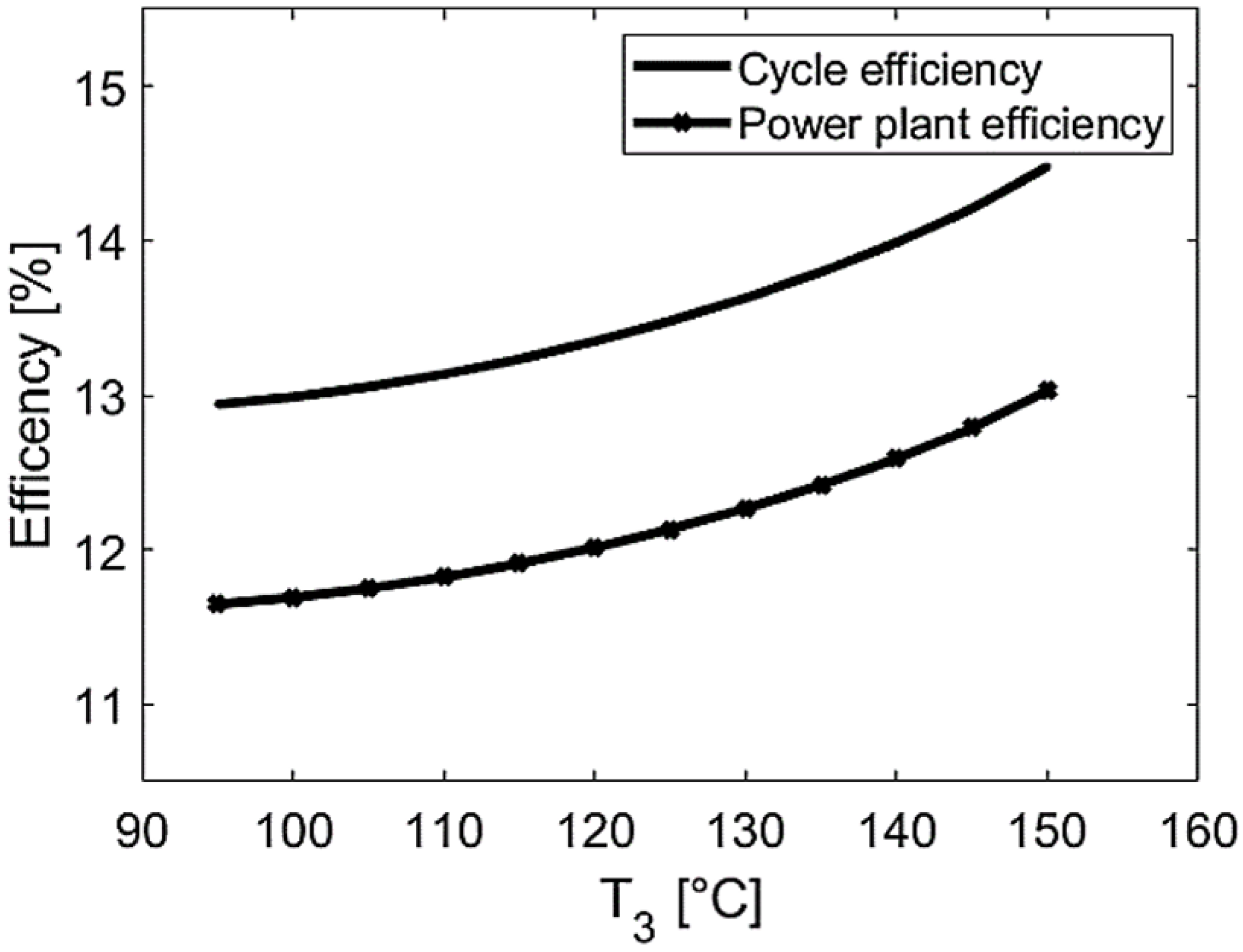
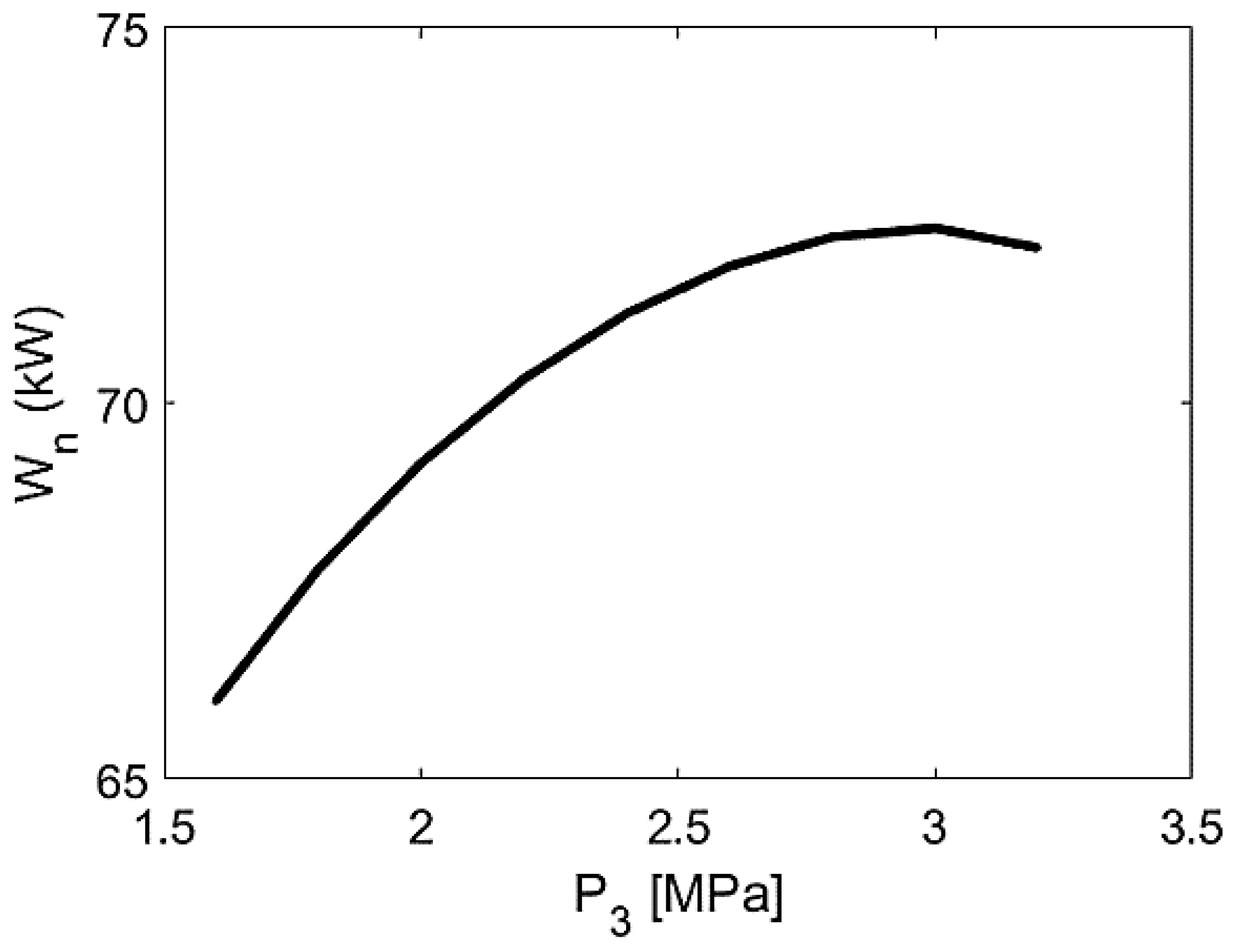


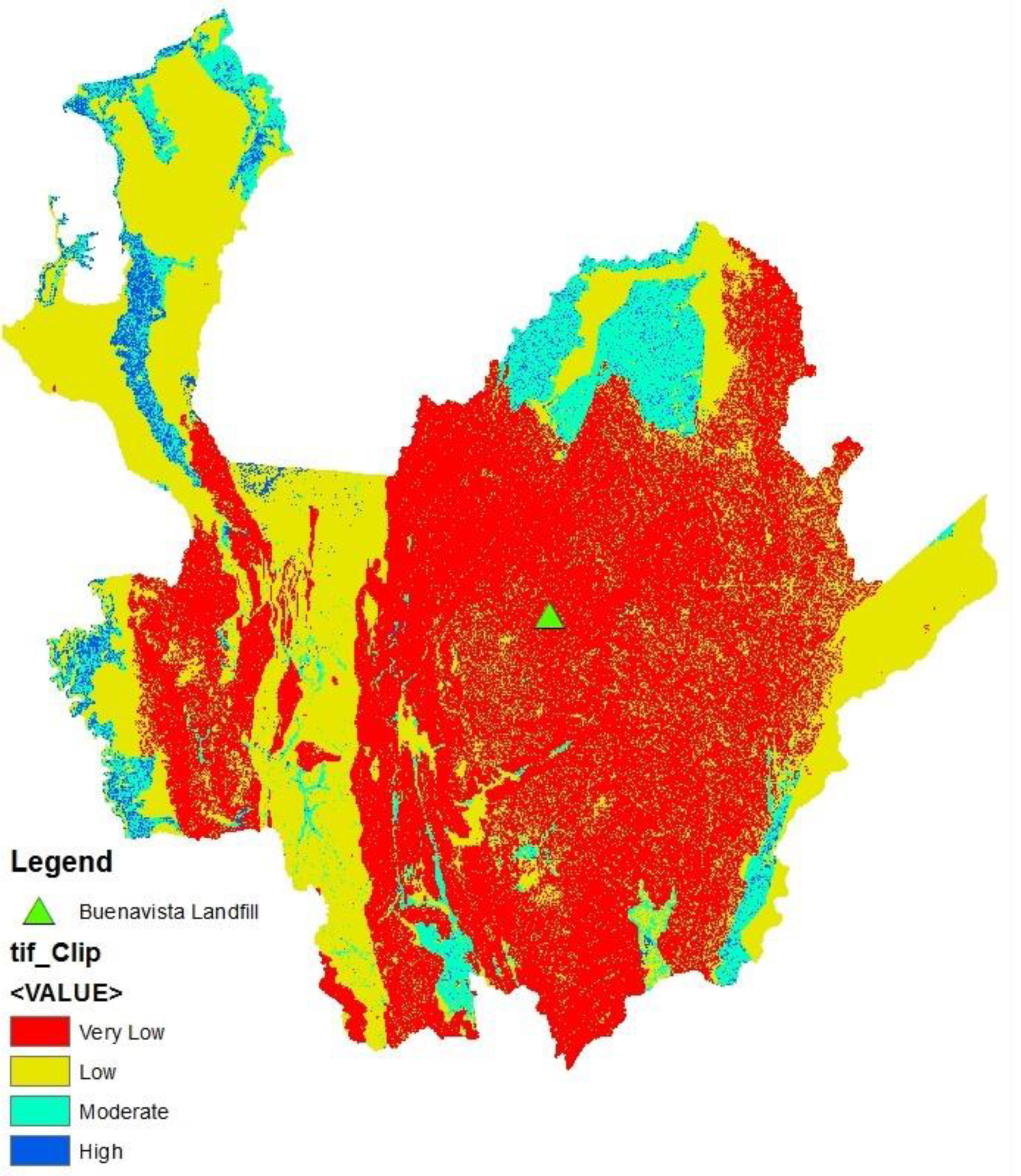
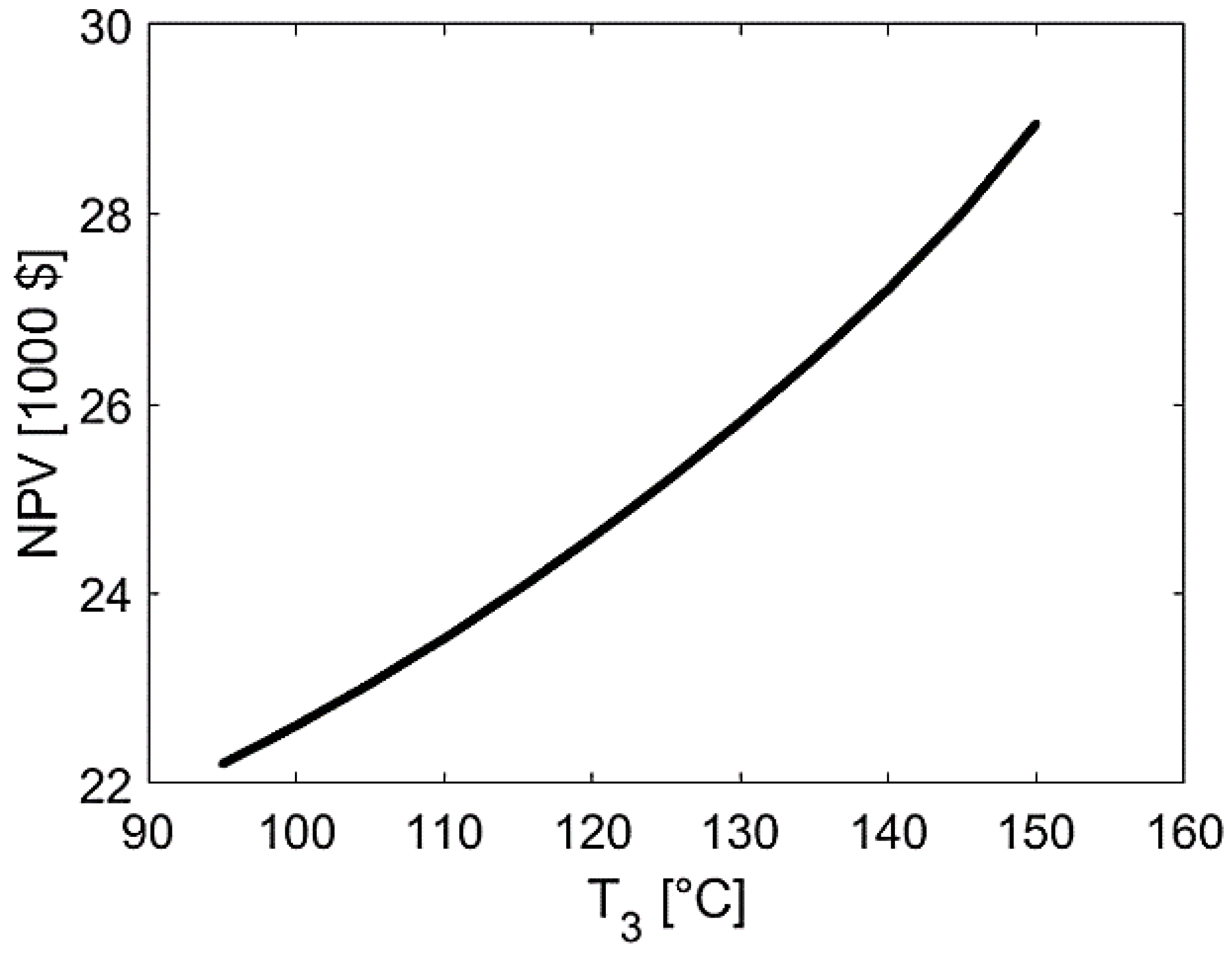
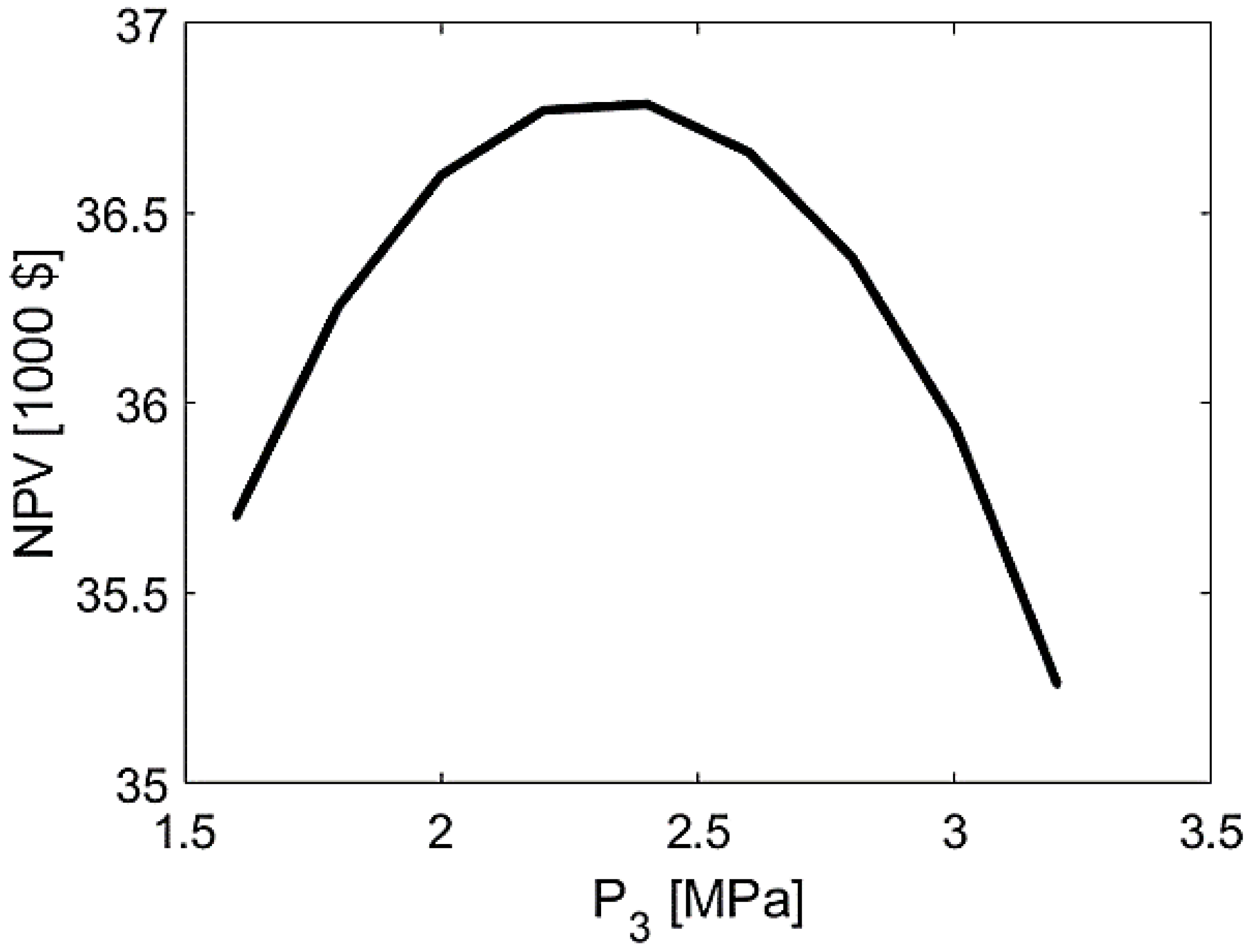
[MPa] | [MPa] | [MPa] | [°C] | [kg/s] | [J/kg] | |||
|---|---|---|---|---|---|---|---|---|
| 0.85 | 0.75 | 0.9 | 0.09 | 3 | 1 | 150 | 0.0016 | 27,766,500 |
| Variable | Equation | |
|---|---|---|
| Position 2 | ), | (1) |
| where corresponds to the specific volume (in ); the subscripts indicate specific states of the system, as depicted in Figure 3; and the subscript s represents the state that corresponds to an isentropic condition. | ||
| (2) | ||
| Position 4 | , | (3) |
| where represents the quality. | ||
| (4) | ||
| (5) | ||
| Position 6 | (6) | |
| (7) | ||
| (8) | ||
| Evaporators | (9) | |
| (10) | ||
| where represents the amount of energy obtained from burning the gas produced in the landfill (in kW). The term correspond to the mass flow rate of R245fa (in ). | ||
| Pump | (11) | |
| Turbines | (12) | |
| (13) | ||
| (14) | ||
| Net Work Output | , | (15) |
| where corresponds to the power (in kW). The subscripts T and P correspond to turbine and pump, respectively. | ||
| Cycle Efficiency | (16) | |
| Power Plant Efficiency | (17) | |
| FTE | (18) | |
| Variable | Range | Value | Weight |
|---|---|---|---|
| Lithology1234567(Permeability) | Very high | 10 | 30% |
| High | 8 | ||
| Moderate | 6 | ||
| Low | 4 | ||
| Very low | 2 | ||
| Land use1234567(Potential infiltration) | Very high | 10 | 25% |
| High | 8 | ||
| Moderate | 6 | ||
| Low | 4 | ||
| Very low | 2 | ||
| Pending | <7° | 10 | 20% |
| 7–15° | 8 | ||
| 15–30° | 6 | ||
| 30–40° | 4 | ||
| >40° | 2 | ||
| Linearity density | Very high | 10 | 15% |
| High | 8 | ||
| Moderate | 6 | ||
| Low | 4 | ||
| Very low | 2 | ||
| Precipitation | Very high | 10 | 10% |
| High | 8 | ||
| Moderate | 6 | ||
| Low | 4 | ||
| Very low | 2 |
| Weighted Sum | Categorization | Meaning |
|---|---|---|
| 0–2.5 | Very low | |
| 2.5–5 | Low | |
| 5–7.5 | Moderate | |
| 7.5–10 | High |
| Parameter | Value |
|---|---|
| Investment cost of reference plant ($/kWel) [2] | |
| Operational and maintenance cost (% of inv. cost/year) [2] | |
| Energy sale price ($/kWh) [3] | |
| Energy purchase price ($/kWh) [3] | |
| Interest rate |
| Variable | Equation | |
|---|---|---|
| Investment | (20) | |
| Earnings | (21) | |
| Costs | (22) | |
| Cash flow | (23) | |
| Net present value | (24) |
| Parameter | FTE | |||
|---|---|---|---|---|
| Results | 64.328 | 7.6736 | 0.1448 | 0.1303 |
Disclaimer/Publisher’s Note: The statements, opinions and data contained in all publications are solely those of the individual author(s) and contributor(s) and not of MDPI and/or the editor(s). MDPI and/or the editor(s) disclaim responsibility for any injury to people or property resulting from any ideas, methods, instructions or products referred to in the content. |
© 2023 by the authors. Licensee MDPI, Basel, Switzerland. This article is an open access article distributed under the terms and conditions of the Creative Commons Attribution (CC BY) license (https://creativecommons.org/licenses/by/4.0/).
Share and Cite
Rocha-Meneses, L.; Zea, J.; Martínez, B.; Arrieta, C.; Risco, M.L.-d.; Villegas, S.; Arredondo, C. Thermodynamic and Economic Simulation of an Organic Rankine Cycle for the Utilization of Combustion Gas Produced in Small Landfills in Antioquia, Colombia. Energies 2023, 16, 6052. https://doi.org/10.3390/en16166052
Rocha-Meneses L, Zea J, Martínez B, Arrieta C, Risco ML-d, Villegas S, Arredondo C. Thermodynamic and Economic Simulation of an Organic Rankine Cycle for the Utilization of Combustion Gas Produced in Small Landfills in Antioquia, Colombia. Energies. 2023; 16(16):6052. https://doi.org/10.3390/en16166052
Chicago/Turabian StyleRocha-Meneses, Lisandra, Jhojan Zea, Brandon Martínez, Carlos Arrieta, Mario Luna-del Risco, Sebastián Villegas, and Carlos Arredondo. 2023. "Thermodynamic and Economic Simulation of an Organic Rankine Cycle for the Utilization of Combustion Gas Produced in Small Landfills in Antioquia, Colombia" Energies 16, no. 16: 6052. https://doi.org/10.3390/en16166052
APA StyleRocha-Meneses, L., Zea, J., Martínez, B., Arrieta, C., Risco, M. L.-d., Villegas, S., & Arredondo, C. (2023). Thermodynamic and Economic Simulation of an Organic Rankine Cycle for the Utilization of Combustion Gas Produced in Small Landfills in Antioquia, Colombia. Energies, 16(16), 6052. https://doi.org/10.3390/en16166052








